Why mobile internet does not work well
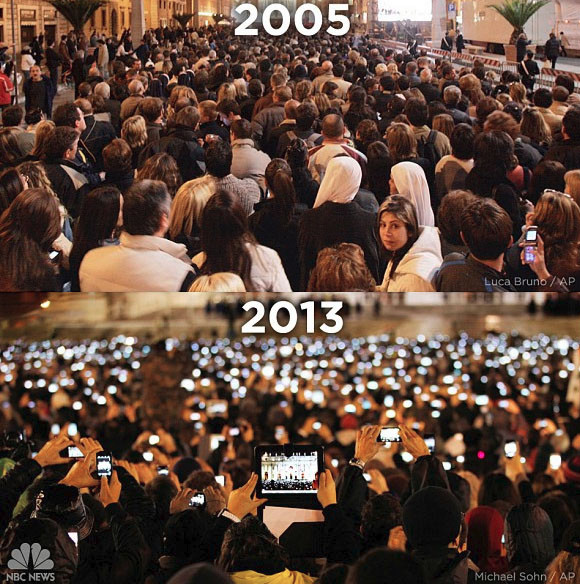
Because the volume of traffic on cellular networks is growing much faster than operators manage to build them. That is, in short. A more detailed analysis, as well as the results of a small experiment and a hint of a solution to the problem under the cut.
Warning: the article contains a large number of illustrations and will take a long time to load if you are reading us from a mobile device.
Theory
Many of us drew attention to the fact that in crowded places, mobile Internet is either very slow or not working at all. Intuitively, this phenomenon is akin to traffic jam - the narrow neck of the operator’s infrastructure is tightly clogged with subscriber traffic.

In fact, the situation with mobile Internet is much harder than the road: the volume of traffic on cellular networks is confidently showing exponential growth (aka geometric progression) with rates from 50 to 100% per annum in different countries, and there is no end to this trend. It is terrible to imagine what would happen on the roads if the number of cars doubled every year.
The authoritative annual study of global traffic volumes is the Cisco Visual Networking Index (VNI). According to the current forecast, the volume of mobile traffic in the world will grow 13 times over the next five years with an average annual growth rate of 66%, reaching 11 exabytes per month in space. In Russia in the same period, sixteen-fold growth of mobile traffic is forecasted, which corresponds to the expectations of growth rates above the world average.

Having raised “approximately 100%” of annual growth to the tenth power, it is easy to obtain a thousand-fold increase in network load in 10 years. Qualcomm, the manufacturer of electronic components, is actively promoting this figure .
The problem of the lack of capacity of cellular networks associated with an exponential increase in load is called the “capacity crisis” (“Capacity Crunch”), which is ominously consonant with the 2008 financial crisis (“Credit Crunch”).
Briefly about the reasons for such rapid growth, the main one, of course, is the “smartphone revolution”. So, only in 2012 the number of mobile Internet users (read, owners of a smartphone and / or tablet) in Russia grew by 88% to 79 million people ( source ). In turn, the widespread use of smartphones and tablets leads to the spread of mobile use of popular services. For example, Youtube cites statistics that 40% (in time) of all viewed content falls on mobile devices. In addition, the average number of mobile Internet devices per subscriber is growing, as well as an increasing number of devices, in addition to smartphones and tablets, get a connection to the mobile Internet and begin to generate and consume traffic.
Finally, mobile traffic is consumed and generated more and more unevenly in space, which further complicates the problem of lack of capacity of cellular networks in “hot spots”. Indeed, if a voice call can be made while running, then the consumption of “heavy” traffic, such as mobile video, gravitates to tables, benches, etc. The illustration below ( source ) shows the distribution of twitter traffic (blue) and flickr (orange) in London.

It is also important to remember that according to various sources, from 70% to 80% of mobile traffic is generated indoors (see, for example, Huawei data ), which makes large public buildings a natural “hot zone” for mobile traffic.
Practice
You may notice that the arguments above refer to data from equipment manufacturers (Cisco, Qualcomm, Huawei) and service providers (Youtube). In the environment of the mobile operators themselves, one can find the opposite opinion that the capacity crisis problem was invented by manufacturers in order to stimulate sales of new equipment (it is as if you believed that the manufacturers of asphalt pavers came up with traffic jams).
To illustrate the real situation, we went to the food court of the nearest large shopping center on Saturday evening, grabbing a laptop and a set of 2G / 3G / LTE modems from all the major metropolitan mobile operators.
Mobile internet bandwidth was measured using speedtest.net, in cases where the speedtest client could not connect to its server, ping 8.8.8.8 was used. We made sure to connect and pay the "most unlimited" tariffs for all operators. For operators providing LTE services in Moscow at the time of the experiment, we connected LTE.
Below, immediately after disclaimer, are the results of this small study.
DISCLAIMER
- We do not advertise or criticize the quality of services of individual operators.
- We are not affiliated with any of the mobile operators.
- We express our personal value judgment based on measurements of the quality of data transfer using publicly available tools.
- The measurement results for various operators are given in random order.
Megaphone
2G - there is network coverage, the signal strength is maximum, the modem is connected to the network. Speedtest cannot connect to the server, ping does not go. Mobile Internet is virtually absent.
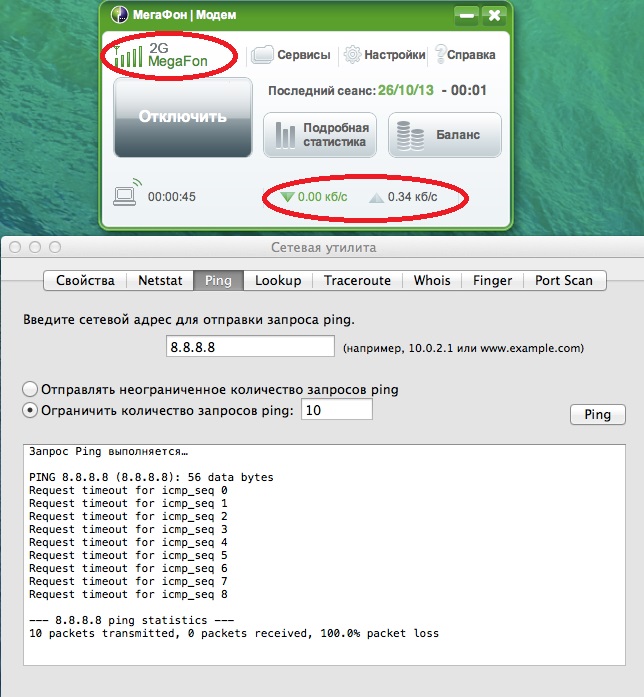
3G - the situation is similar, the signal level is at maximum, there is a connection, there is no Internet.

4G / LTE - the modem showed a minimum signal level and refused to connect to the network. This happens in large buildings, even with a satisfactory level of coverage outside.
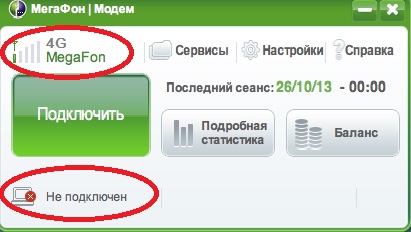
Beeline
2G - a situation similar to 2G of other operators, screenshots, unfortunately, were lost.
3G - fixed speed!
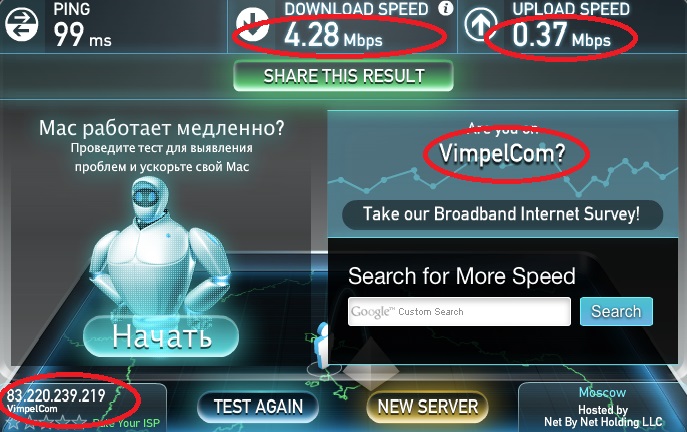
Re-measured: yes, indeed, there is speed. The instability of the readings indirectly indicates a high network load.
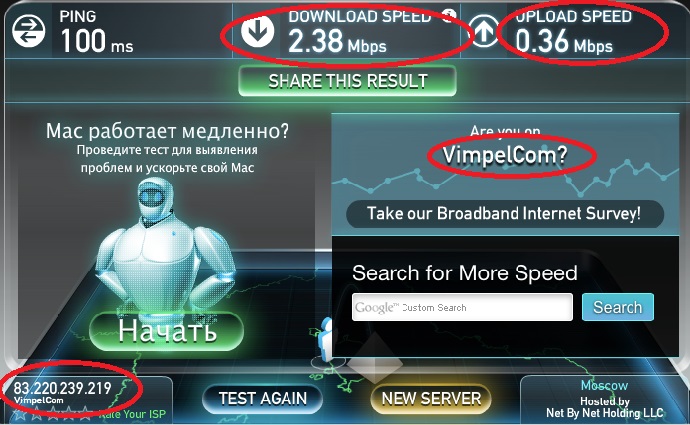
At the time of the experiment, Beeline had not yet launched the 4G / LTE network in commercial operation in Moscow.
Yota
We connected to the LTE Yota network via a mobile Wi-Fi router, so in the screenshot the network is visible as a Wi-Fi network with the SSID “yotanelovit”. The router is connected to the LTE network, and the laptop is connected to the router. However, speedtest could not connect to the server, and ping showed at the same time a huge delay, packet loss, and even duplicate packets. Based on these data, it is difficult to make an unambiguous conclusion about the cause of the problems - in a low signal level or in network congestion, we will leave this question unanswered.
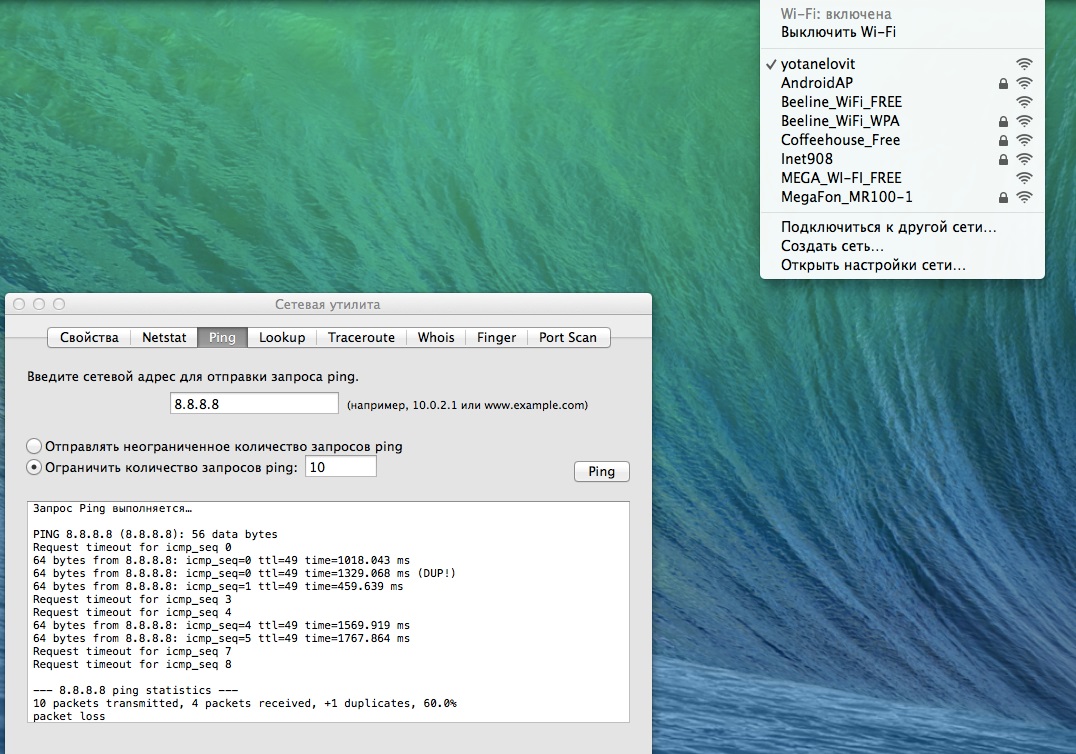
Free wifi
In addition to the results for Yota, the illustration above shows another interesting phenomenon - as many as three networks of free Wi-Fi. In practice, we were not able to connect to any of these networks - the capacity crisis concerns Wi-Fi networks to the same extent, if not more than cellular networks.
The presence of a Wi-Fi network with the “AndroidAP” SSID most likely indicates that, besides us, someone else at the food court could not connect to free Wi-Fi and chose to “distribute” Wi-Fi from the phone.
We also note the Wi-Fi network with the SSID “Megafon_MR100-1” - this is the name of the 2G / 3G / LTE mobile router in Wi-Fi branded for Megaphone. Most likely, one of the visitors to the shopping center was more fortunate than us to connect this operator to the network, which once again testifies in favor of the network congestion hypothesis.
MTS
2G - there is network coverage, the signal strength is maximum, the modem is connected to the network. Speedtest cannot connect to the server, ping does not go. Mobile Internet is virtually absent.

3G is the same as 2G

In the 4G / LTE MTS network, we recorded a decent speed (see illustration below).

We repeated the measurement, the speed is normal and relatively stable, which may indicate an unloaded network.

In general, we are inclined to explain the good LTE results from MTS by the low prevalence of subscriber equipment compared to 3G and LTE from Yota. Recall that MTS and Megafon use the unique TD-LTE option for Russia in Moscow and the region in the frequency range 2595-2620 MHz.
Summary
So, the crisis in the capacity of cellular networks in a particular shopping center is a real problem that all mobile operators in the Moscow region face. The key symptom is a very low or zero data rate with a high signal level.
Is there a way out?
Yes. Shaping, traffic compression and caching, the radio frequency spectrum, LTE and LTE-A, Wi-Fi offload, as well as femtocells, picocells, microcells, metro cells and (except for jokes) nanosotes - all this in the next article.
Happy New Year to all!
